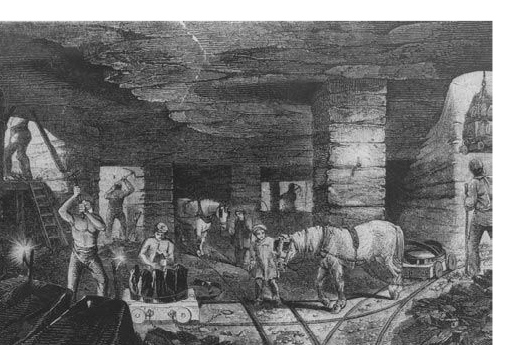Early years
Thomas Harvey was born in about 1799 probably in the West Midlands around Oldbury.
Like most children of working-class families, he received no more than a year or
two of schooling and could not read or write. By about the age of eight, he was most
likely working at the local pit.
The coal mining and iron working industries developed rapidly from the end of the
eighteenth century as new technology made deep cast mining possible. The industry
employed men and women from as young as about six. Children began by carrying broken
picks to the smith to be repaired, helping to empty the skips that were sent up to
the coal face, running errands, or controlling the air doors in the pit, or filing
sacks with coal. There was always work to do; the day was long and hard and no one
went idle. After a couple of years, Thomas took up heavier work such as pushing the
carts in the pit, and by about age 12, he was most likely wielding a pick, quickly
building up his strength and learning how to cut the coal seam. The illustration
on the right shows the Bradley Mine near Bilston in the early nineteenth century.
Down the mine
The working day started at six in the morning and finished at six at night. It was
hard, physical work. An account of 1842 describes how the holer or hewer would ‘lay
himself on his side and holding his pick in both hands strikes against it (the seam)
with all his force, throwing all the weight of his body into the blow and brings
out the coals. A day’s work of a pickman is one yard six inches in front and two
yards inwards, and two feet high’. There was an hour for lunch down the pit, in an
large area cut out for the purpose. A Royal Commission of 1842, set up to look at
conditions in the mines, particularly in relation to child labour, paints a vivid
picture of the lunchtime break:
“It is a fine sight to see the miners congregated at dinner, in a large dining hall
cut out of the coal. There they sit, naked from the middle upwards, as black as blackamoor
savages, showing their fine, vigorous, muscular persons, eating, drinking, and laughing.
They sit an hour and then resume their labours.”
Thomas’ lunch would have been brought to the pit bound up in a handkerchief by one
of his relatives. Everything was loaded into a skip and sent down the shaft; each
man knew his dinner by the pattern of the handkerchief in which the food was wrapped.
The mine provided a quart of pit beer to accompany the meal, and another quart at
the end of the day, when Thomas and his fellow miners ascended the pit into the room
lit by a fire.  The depth of the mines meant that the men were a constant warm temperature
and miners escaped the cold, rain, snow and frost until they emerged above ground
at the end of their twelve-hour shift.
The depth of the mines meant that the men were a constant warm temperature
and miners escaped the cold, rain, snow and frost until they emerged above ground
at the end of their twelve-hour shift.
The working week was six-days long, although work finished early on a Saturday and
there might also be a ‘holiday’ once a fortnight. Saturday was the day for a good
wash with hot soap and water, and Sunday the day for chapel or church, lunch and
then a rest in the afternoon followed by a walk or a lie down on the grass to soak
up the sunlight. The Commission noted that leisure time was spent, ‘chiefly in the
public-houses, drinking beer, and singing and dancing the double shuffle, to the
music of the fiddle or hurdy-gurdy. The noise of the shoes is the source of delight
in this dance and the hobnails of the colliers afford great advantage. Sometimes
in summer they will sit all round the door of the public-house in a great circle
all on their hams and every man his bull-dog between his knees and in this they position
they drink and smoke’.
Married life
Whether Thomas meat Sarah Grigg in the public-house or the church, they were married
on 13 December 1824 at the Parish church in Dudley. From Dudley, Thomas and Sarah
moved to Oldbury. A son, Joseph, was born not long after, followed by four daughters:
Mary (circa 1828), Ann (circa 1823), Elizabeth (circa 1834) and Sarah (circa 1835).
There may have been other children between 1823 and 1834 who did not survive infancy:
in the West Midlands, almost one in two children died under the age of three; one
of the worst records of infant mortality in England.
During this time, Thomas and his family continued to live in Oldbury and in 1841
were at Shidas Road. Thomas continued working as a miner. It was a dangerous job
and miners could expect at least one injury at some time during their working lives.
Just how dangerous was proved on Tuesday 17 November 1846. Just before six o’clock,
Thomas left for work as usual. Not long after, at about 6.45am, the ground shook
and there was a huge explosion. In a town where a quarter of the population were
employed by the mines, Sarah did not need to ask the cause: pit explosions happened
all too frequently. Sarah rushed to the pit together with the people of Olbury (reportedly
in their thousands), to be met by the sight of clouds of sulphurous vapour and flames
leaping from the shaft. It took all day to remove the horribly burned bodies and,
as each body was brought out, the crowd surged, trying to see if the victims were
husbands, fathers, brothers or uncles. In all, nineteen bodies were recovered; five
miners also had terrible injuries and four escaped unharmed. Thomas was probably
working for another colliery, but Sarah would have looked on in the realisation that
it could have easily have been her husband instead of those of her neighbours. The
bodies were taken home by cart and a local newspaper account added, “It is difficult
to imagine the sight of such horribly burned bodies lying at home, perhaps for days
before burial”.
The inherent dangers of mining meant that miners were well paid compared to workers
in other branches of industry. On average, boys working in the mines earned two or
three times the wage of other boys their age, and by the age of fourteen might be
earning 15s a week (1842). Certainly in 1851, Thomas’ wage was supporting his wife,
Sarah, and their daughter, Ann Brown (already widowed by the age of 22) and her infant
daughter, Betsy. His son, Joseph, also a miner, was living at home with his young
wife, Elizabeth.
Thomas continued working as a miner and in 1861 was still living in Oldbury with
Sarah. His daughter, Ann, had remarried and was living next door with her husband,
John Rogers, and their five children. Thomas remained in Rounds Fold in Oldbury,
although by the mid-1860s work became too physically demanding and the 1871 census
records him as having ‘no occupation’. Not long after, he started working at the
colliery as a watchman. On 17 January 1872 he was injured, presumably at work, and
died as a result of his injuries, although his death certificate does not provide
any further information. The dangers of mining were not just below ground and colliery
records document the deaths of watchmen from causes as diverse as falling through
a hatch and being hit by a gate during bad weather.



 The depth of the mines meant that the men were a constant warm temperature
and miners escaped the cold, rain, snow and frost until they emerged above ground
at the end of their twelve-
The depth of the mines meant that the men were a constant warm temperature
and miners escaped the cold, rain, snow and frost until they emerged above ground
at the end of their twelve-